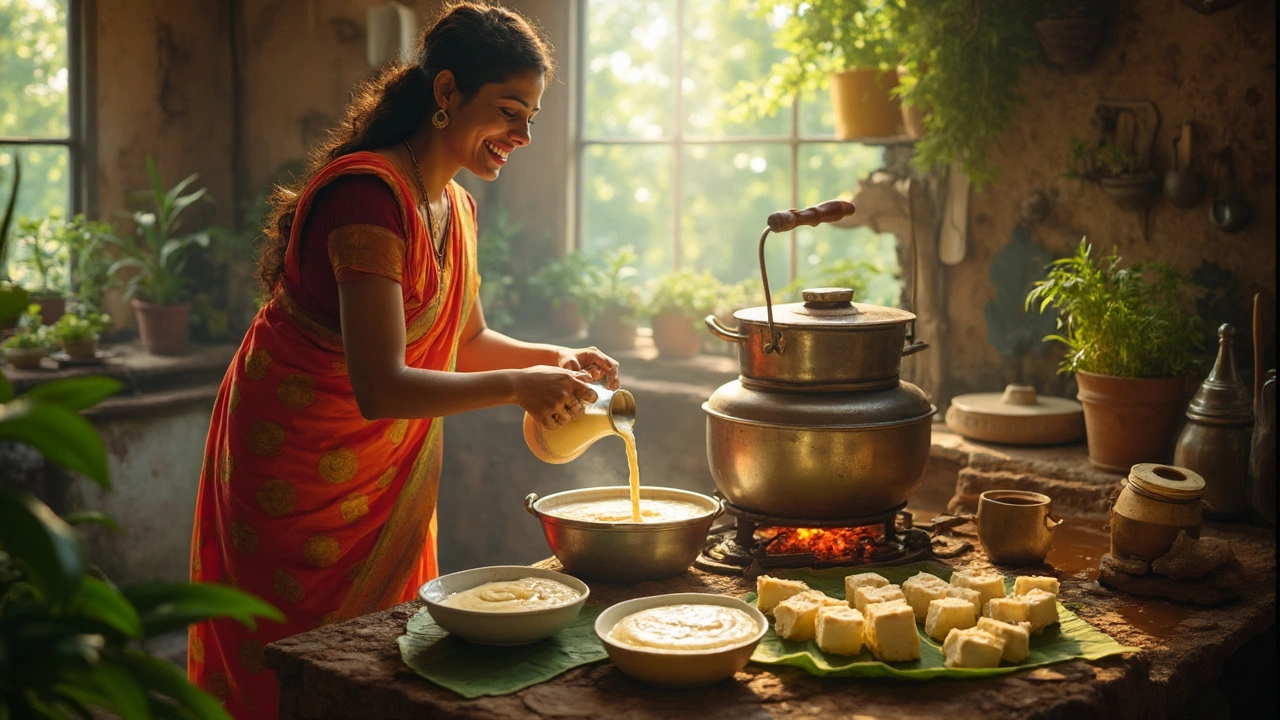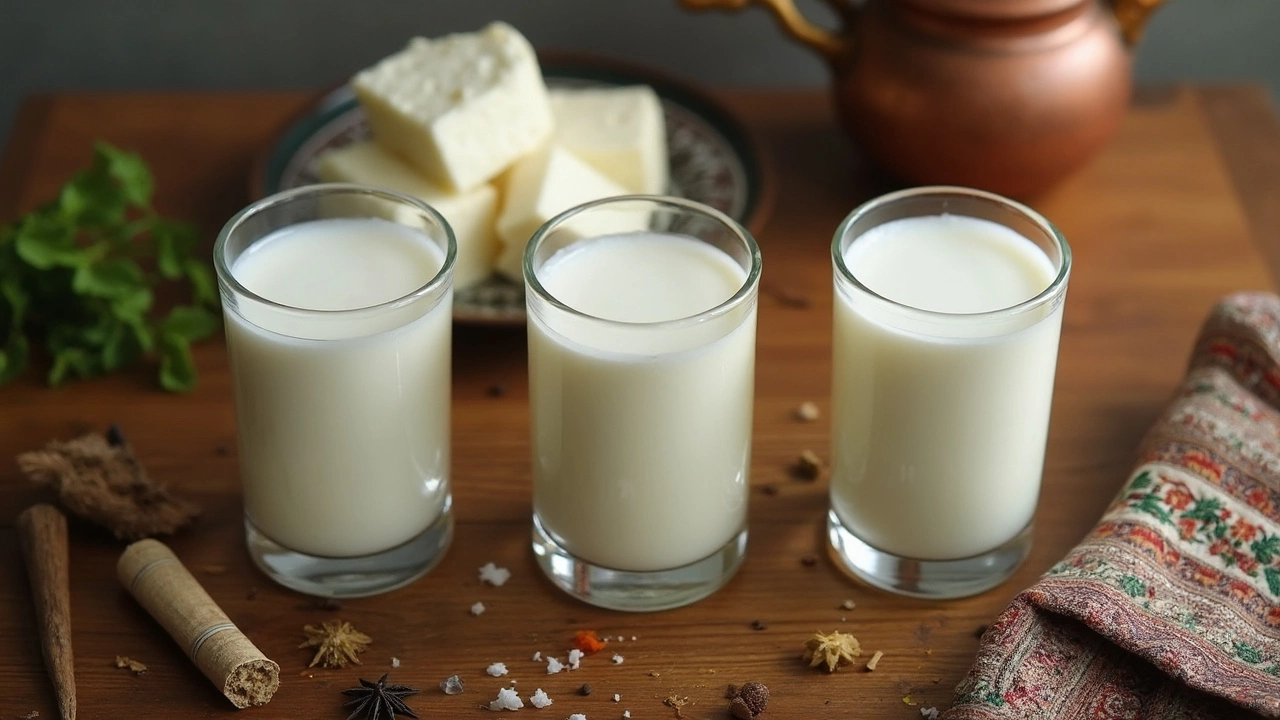Which Milk Is Preferred for Paneer Making? Homemade Answers
 Jun, 16 2025
Jun, 16 2025
Picking the right milk for homemade paneer is where it all starts. You’d be surprised—your choice here could make or break the whole batch. Most folks just grab whatever’s in the fridge, but not all milk is created equal when it comes to good, soft paneer.
Full-fat milk is the hero here. If you want that creamy, rich paneer that doesn’t crumble or turn rubbery, aim for full-cream milk. Think fresh, not skimmed or low-fat. It’s all about the fat and protein—the more, the better your paneer holds together and the softer it feels. Skim milk? You’ll end up with tough, dry chunks you just don’t want to eat.
Buffalo milk actually has more fat compared to cow’s milk. So, if you notice paneer from the store that’s super-rich and velvety, chances are it’s made from buffalo milk. But honestly, good old regular cow’s milk (full-cream, not toned) works great at home and is much easier to find in a lot of places.
UHT (ultra-high-temperature) or long-life packaged milk is handy, but there’s a catch. The high heat treatment can kill the proteins that help curdle the milk right, so your paneer can come out grainy or with low yield. If you only have access to packaged milk, just know the results won’t be as perfect as fresh dairy—but it’s definitely doable if you’re in a pinch.
- Milk Types That Work Best
- What Each Milk Means for Texture and Yield
- Quick Tips for Better Paneer
- Common Milk Mistakes to Avoid
Milk Types That Work Best
Alright, so you want that perfect, soft homemade paneer. The milk you choose is your main player. Let’s break down what actually works best at home.
If you’re after the real deal, go with full-fat cow milk or buffalo milk. Both types deliver a high yield and that creamy texture everyone loves. Don’t go down the skim or low-fat route unless you want crumbly, dry paneer—it’s just not worth it. Stick to milk that has at least 3% fat, though more is always better for paneer.
- Full-Fat Cow Milk: This one’s easy to find and gives you soft, smooth paneer with a nice neutral flavor. It’s got decent fat and protein levels—makes things straightforward if you’re just starting out.
- Buffalo Milk: Packs even more fat—usually 6% or more—so it makes super-rich paneer. The texture is firmer, and the curds set faster.
- Farm-Fresh Milk: Unpasteurized, straight-from-the-dairy is another winner. It’s loaded with both fat and protein, but be sure it’s safe and properly boiled before you use it.
- Packaged or UHT Milk: Works in a pinch, but don’t expect miracles. The ultra-high temp treatment messes with the proteins, so yield is a bit lower and the texture isn’t quite as creamy.
Check out this simple breakdown to see how milk type matters:
| Type of Milk | Average Fat % | Paneer Texture | Yield (per liter) |
|---|---|---|---|
| Buffalo Milk | 6-8% | Rich, firm, creamy | 225-250g |
| Full-Fat Cow Milk | 3-4% | Soft, moist | 175-200g |
| Skim/Low-Fat Milk | 0.5-2% | Dry, crumbly | 100-120g |
| UHT/Packaged Milk | Varies | Less creamy, sometimes grainy | 150-180g |
If you want soft paneer that soaks up curry flavors and stays tender, always start with paneer-friendly, full-fat milk. The extra fat and protein really make all the difference.
What Each Milk Means for Texture and Yield
The type of milk you choose does more than just tweak the taste—it controls how soft, creamy, and plentiful your paneer will be. The key players? Buffalo milk, cow’s milk, and the ever-popular packaged variants.
Buffalo milk comes out swinging with its high fat content. That extra cream leads to paneer that’s velvety, almost buttery in texture. You’ll get a firmer slab that’s perfect for cubes and doesn’t crumble when fried. The yield (how much paneer you actually get) is higher simply because more solids separate out of the richer milk. A quick stat: from 1 liter of buffalo milk, you can expect around 250–270 grams of paneer. Cow’s milk? Slightly less—think 160–200 grams per liter since there’s less fat and casein to work with.
Here’s a quick breakdown you can actually use:
| Milk Type | Average Fat (%) | Paneer Yield (g per liter) | Texture |
|---|---|---|---|
| Buffalo Milk | 6–8% | 250–270 | Dense, creamy, firm |
| Cow Milk (Full Cream) | 3–4% | 160–200 | Softer, crumbly, lighter |
| Packaged/UHT Milk | 2–3.5% | 130–170 | Grainy, sometimes rubbery |
If you’re chasing the softest bite possible, go for fresh, full-cream cow’s milk. It’s easier to handle, less likely to turn rubbery if accidentally overheated, and gives a lighter paneer—great for dishes where you want absorbing flavor.
With skimmed or low-fat milk, just don’t do it. The paneer will be tough and barely hold together when cutting. Paneer supposed to soak up curry—that’s not happening with a dry, chewy block!
And if you’re using goat or plant-based milks, lower your expectations. These just don’t have the casein and fat needed for classic paneer texture or yield and tend to be messier and bland.
Bottom line: higher fat and protein equals better, more plentiful paneer. You’ll spend the same amount of time, so grab the milk that pays off the most—your palate (and wallet) will thank you.

Quick Tips for Better Paneer
If you’re after soft, rich homemade paneer, don’t just wing it. There are a few tricks to help you get that restaurant-style result, even with basic ingredients. Here’s how to make sure your effort isn’t wasted on rubbery cubes or grainy lumps.
- Always start with full-fat milk. The higher the fat, the creamier your paneer. Borderline obvious, but folks still grab skim by mistake and then complain about the texture.
- Bring milk just to a boil—don’t let it bubble over. Once boiling, lower to a medium flame and add your acid (lemon juice or vinegar) slowly, while stirring. This keeps the curds tender.
- As soon as the milk splits, take it off the heat. Overcooking can make paneer stiff.
- Drain the curds with a soft cheesecloth or muslin. Rinse with cold water to wash out the acidic taste, then squeeze gently. Don’t go wild or your paneer will turn dry.
- Press the paneer with an even weight (think a pot of water or a stack of plates) for 30–60 minutes. More time gives firmer paneer. Want it softer? Cut the pressing short.
- Add a pinch of salt before pressing if you want the flavor to really pop—it makes a difference, especially for snacks or salads.
- If you have access, use buffalo milk for extra creamy blocks, or try half-and-half with cow milk for balance.
- For those counting grams, 1 liter of full-fat cow milk gives about 200g of paneer, while buffalo milk can give up to 250g.
| Milk Type | Paneer Yield (per 1L milk) | Texture |
|---|---|---|
| Full-Fat Cow | ~200g | Soft to medium |
| Buffalo | ~250g | Very creamy, soft |
| Toned/Low-Fat | ~100-120g | Dry, crumbly |
Keep these tweaks handy next time you make paneer. Just a little attention to small details can easily double your chances of nailing that perfect batch.
Common Milk Mistakes to Avoid
It’s easy to mess up when picking milk for making paneer, even if you’ve done it a few times. Learning what not to do can save a lot of time and hassle.
- Skim or Low-Fat Milk. This is the big one. Skim milk just doesn’t have enough fat to bind the curds well. The result? Dry, crumbly paneer that’s no fun to eat or cook with, and your yield is much lower. Always go for full-cream or whole milk.
- Using UHT or Ultra-Processed Milk. Supermarket milk that’s shelf-stable (UHT or long life) sounds handy, but there’s a catch. The high heat kills off some of the proteins that help curdle milk, so the curds barely form or they split oddly. You might barely get any paneer at all.
- Old or Stale Milk. Slightly sour milk works if you’re in a pinch, but truly stale milk? No thanks. Bad milk makes odd-smelling paneer and the texture gets weird. Smell it first—if it’s off, skip it.
- Milk With Additives. Some processed milk brands sneak in stabilizers or thickeners that can totally change how your milk reacts to acid. These additives stop your curds from coming together, leaving you with a watery mess instead of firm paneer blocks.
- Cow vs Buffalo Milk Without Adjustments. Buffalo milk gives you richer paneer, but it also needs less acid to set. Use lemon juice or vinegar a little bit at a time—if you overdo it, you get too-firm curds.
Here’s a quick look at the results you can expect from different milk types when making paneer:
| Milk Type | Fat Content (%) | Paneer Texture | Yield (g/L milk) |
|---|---|---|---|
| Full-Fat Cow Milk | 3.5-4 | Soft, moist | 220-250 |
| Buffalo Milk | 6-7 | Creamy, dense | 280-300 |
| Skim Milk | 0.1-0.5 | Dry, crumbly | 120-150 |
| UHT Milk | Varies | Grainy, low volume | 100-130 |
If you want the best results, always check the label and avoid anything with added chemicals. Stick to fresh, whole milk and you’ll notice a massive difference in taste, yield, and texture the next time you make your own paneer.
